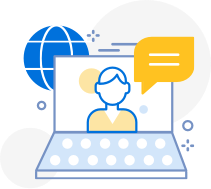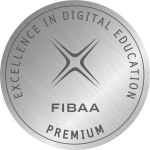Blended learning combines the best of two learning worlds – it combines traditional classroom training and virtual learning. This method offers learners considerably more flexibility than traditional face-to-face seminars. But how does blended learning actually work? You’ll find out in this article.https://www.youtube.com/embed/E62s6JRKTpg?controls=1&rel=0&playsinline=0&modestbranding=0&autoplay=0&enablejsapi=1&origin=https%3A%2F%2Fsca.online&widgetid=1
Definition
In blended learning, learners participate in learning sessions delivered by an instructor in a traditional classroom setting. There are also online media offerings. Because blended learning combines analog and digital elements, it is also known as hybrid learning. It is precisely this combination of face-to-face and online phases with the use and implementation of media.
One of the biggest advantages of the blended learning concept is that the method accommodates a wide variety of learning types and preferences. And that is very important, especially in today’s corporate training. Because currently the learning preferences of employees are drifting far apart. Simply because generations with completely different social backgrounds come together in the working world.
How do the terms blended learning and e-learning relate to each other?
Blended learning and e-learning are terms that are frequently used in the corporate world. They are two terms that are used interchangeably, but they have different meanings. The term “blended learning” is used to describe a type of instruction in which students participate simultaneously in traditional face-to-face classes and online courses via media. “E-learning,” on the other hand, refers to the use of electronic media and technology for teaching and training purposes. So what is the difference between blended learning and e-learning?
Blended Learning = A form of instruction in which students participate simultaneously in traditional face-to-face and online courses.
E-learning = The use of electronic technologies for teaching and training purposes.
Everyone is currently asking: Is online learning the future of teaching?
Learning is constantly changing and evolving, but will it be replaced by technology in the near future? For a long time, people have believed that teachers are an important part of education. With all the changes taking place in technology, how can we ensure that this form of teaching will last for many years to come?
It’s easy to see how online classes have benefited so many people in the Corona era, but now is the time to think about whether or not this form of education will replace traditional classrooms altogether. Spoiler: She won’t. Corporate training departments and training companies themselves are finding that, on the one hand, home office and online distance learning are usually just as efficient as face-to-face and classroom learning, but the most efficient form of learning is a blend of online and face-to-face learning.
These forms of learning have been around for many years, and as long as we can keep up with the changes online and technologically, they will be around for many years to come. Many educators believe that this form is not only an important part, but crucial to ensuring.
The blended learning concept: face-to-face and online learning – learning success for all types of learners
The challenge for organizations that want to introduce blended learning is the different socializations of their employees. While the baby boomers, who were born up to 1964 and only came into contact with a computer for the first time in their twenties or thirties, there are generations X and Y, who experienced digitalisation in their youth and childhood respectively. Last but not least, there is Generation Z, which has grown up completely in the digital age – the so-called digital natives.
Conversely, this means: In corporate training, there are employee groups that are less to very open to digital learning. With a blended learning offer you can pick them all up.
What are the advantages of blended learning?
However, apart from being compatible with different learning preferences, there are other plus points that blended learning brings to the table. We would like to introduce these to you briefly:
#1 Blended learning is extremely varied
The variety of learning opportunities used in blended learning learning methods is greater in no learning format. While on-site learning offers the possibility of using role-plays, group discussions and group work, online learning offers complementary formats such as learning games, videos, tutorials and chats.
#2 More independent of time and place
At least with online learning units, learners are highly flexible in terms of time and location. They can access and work on a single topic or the entire units whenever it suits them best. When driving to work, for example, or in idle phases at work when there is not much to do at the moment.
#3 Blended learning picks up everyone at the right level
Workers with very different levels of prior experience can participate in blended learning courses. Blended learning creates a kind of learning buffet and the learners can decide for themselves, especially in the online learning units, at which learning level they want to start or which content they would like to deepen again. In this way, learning takes place much more effectively and purposefully.
What blended learning methods are available?
We have noted elsewhere that blended learning uses a wide range of learning methods. Now let’s take a closer look at what they are specifically.
#1 The rotation model
In this model, the instructor alternates between on-site learning and virtual learning. Seminar participants rotate back and forth in equal parts between face-to-face learning and remote lessons.
#2 Flex Learning
Flex learning, on the other hand, allows learners to choose whether they attend training in person in the classroom or online from their desks or homes. The principle: A seminar takes place in a training room equipped with high-quality video and audio equipment as well as interactive whiteboards. The training can be attended live or streamed. Both on-site and all online participants experience a first-class learning experience.
#3 Gamification
One of the most effective ways to motivate is to let them play! Through the use of gamification elements such as quizzes or challenges, in which points can be earned, participants in continuing education enter into positive competition with each other. This motivates them to complete the material faster.
#4 Online Lab (pure e learning)
Blended learning providers often offer what is called an online lab that can be accessed digitally. A wide variety of content can be accessed via smartphones or laptops: Presentations, technical articles, white papers, industry blogs or videos. In this way, contents can be deepened in a targeted manner.
More tips and arguments for good learning methods
We all know, both in theory and in practice: learning is a lifelong task, because there is no person in the world who does not learn. But there are some learning methods that lead to success better than others. Learning is a fundamental human activity. But not all learning is equal. In fact, science has shown that we are more likely to learn and retain information when it is presented in an engaging way, which can also depend on an individual’s strengths. Finding the right way to present information can take time, but there are a few things you can do to make your presentations to make it as effective as possible. Thus, retention rates can be improved by adapting the way you present the material to the needs or preferences of the participants.
There are numerous ways to take in information that may or may not be successful. The theory of learning types assumes that individuals prefer certain ways to gather knowledge and skills and to understand new material. For example, you heard something but didn’t quite understand what was said; later, when you’re researching online at home (or elsewhere), your curiosity is sufficiently piqued by a particular word or phrase – voila! You are able to store the information indefinitely after understanding the meaning through the context clues surrounding the words/phrases you last encountered when they were spoken aloud, whether that was minutes or hours ago.
The likelihood of you retaining information this way:
- Listen to something only: 20 percent
- See something only: 30 percent
- See and hear something: 50 percent
- Seeing, hearing and explaining something: 70 percent
- Seeing, hearing, explaining and doing something yourself: 90 percent.
So, the optimal learning method
What are the best technologies and building blocks to use for continuing education?
Blended learning, especially in adult education, is a new trend in quality education that has emerged due to the popularity of mobile technologies and media. This is a form of learning in which instructors combine face-to-face instruction with computer-based content, also known as “flipping” the classroom.
The following building blocks now exist in blended learning:
- Video units
- Webinars
- Live chat
- Forum
- E-mail exchange
- Teaching letters / technical articles / script (excerpts)
- Audio files
- Exercises
How to measure your training success and learning transfer
This question is important for a variety of reasons. If you’re a HR manager, it’s important to know how much training has been done and what kind of impact it has had on employees. The CEO will want to know if there has been a return on investment in the form of cost savings, increased sales, etc. Additionally, the CFO will need to understand if the company has spent more money than it saved by implementing new policies.” “This blog post provides information about different ways training can be measured so you can decide which ones method best suits your business.”
Are there also further training courses for managers based on the blended learning model?
There are blended learning offers for all target groups – including prospective and experienced managers. For managers, for example, a blended learning course that prepares them for the recognized SVF Leadership certificate is recommended.
The course includes the following main topics:
- Self-knowledge
- Self-Management
- Presentation
- Team leadership
- Communication
- Conflict Management
Another further training tip for leaders: A blended learning course with a focus on management , which also ends with the recognized SVF certificate. He focuses on topics such as general management, personal management and change management.
Participants can complete both courses at the Swiss Mobile Academy. The offer includes both online learning and attendance phases. In addition, participants deepen their knowledge via the SCA learning platform with videos, podcasts, e-lessons and e-tests. They also belong to a class with a maximum of 16 participants. Curious now? Then contact us at any time. Our team will be happy to advise you
What is Blended Learning Design?
Blended learning design is a technique that combines the best of both worlds to get the most out of your training. Blended Learning Design, or BLD, is a method developed by David Warlick when he was at the Graduate School of Education (GSE) at Carnegie Mellon University. It has been adopted by schools around the world as an innovative solution to meet their needs for effective and engaging teaching with limited resources. The goal is to engage student interest through interactive multimedia content delivered online; provide an opportunity for practice through simulations and hands-on activities; build knowledge through project work.
Blended learning design is the process of designing and creating a course that combines traditional face-to-face, self-paced learning and online courses. It’s important to consider what type of learner you are when thinking about how to design your course. For example, if they are an auditory or kinesthetic type of learner, then it would be best for them to find the material in a way other than reading slides or watching videos. Or if they have a short attention span, then maybe breaks need to be built into the lesson plan to help them refocus. Blended learning design is not only about meeting each learner where they are, but also about creating an engaging experience that helps learners retain information better by using multiple methods instead of just one.
What is Social Blended Learning?
Social blended learning is a teaching method that combines online and offline course material. It is becoming increasingly popular in higher education as it can be more cost effective, reduces the need for classrooms and lectures and the argument prevails that it increases student engagement. The first step to social blended learning is to establish an online presence through social media platforms such as LinkedIn, Twitter, Facebook or Instagram. Next, create videos that are enhanced with graphics, audio clips, etc. so that students can watch them on their own time without having to attend live classes. Finally, solicit feedback by asking questions or assigning projects that will provide students with valuable experience while giving your organization valuable insight into what they want from your future offerings.
Conclusion
The success story of blended learning in adult education shows that it is almost a must for many companies – if they do not already have solid knowledge. However, there are still many stumbling blocks and obstacles to overcome with this form of learning. Have you ever worked with blended learning? We offer you comprehensive advice!









